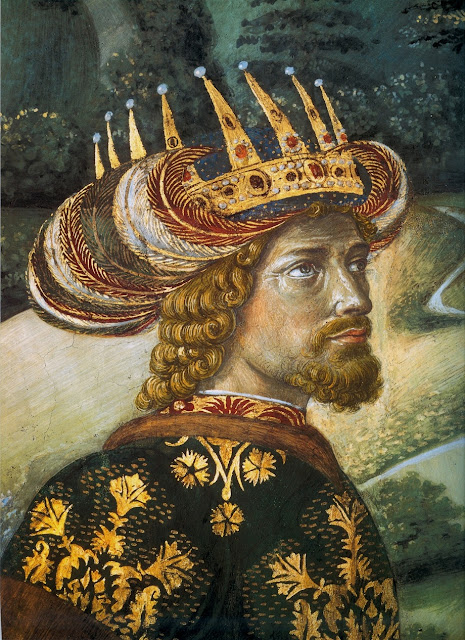In medieval & Tudor England, the Twelfth Night marked the end of a winter festival that started on All Hallows Eve — now more commonly known as Halloween. The Lord of Misrule symbolized the world turning upside down. On this day the King & all those who were high would become the peasants & vice versa. At the beginning of the Twelfth Night festival, a cake that contained a bean & perhaps a pea was eaten. The male who found the bean would rule the feast as a king. Midnight signaled the end of his rule, & the world would return to normal. The common theme was that the normal order of things was reversed. This Lord of Misrule tradition dates back to pre-Christian European festivals such as the Celtic festival of Samhain & the Ancient Roman festival of Saturnalia. In some places, particularly south-western England, Old Twelfth Night is celebrated on 17 January. This continues the custom on the date determined by the old Julian calendar. In England, the lord of the manor was charged with the solemn responsibility of providing the Twelfth Night cakes for his tenant families. This usually informal practice achieved the status of law at the village of North Curry, Somerset, in 1314.

Dancing, clowning, & consuming prodigious quantities of liquor and food, the celebrants followed the practice of crowning one of themselves "king" to rule over the 12th Night's celebrations. Those who donned the crown were also expected to treat their fellow revelers to a round of drinks. During the Renaissance, some of the most splendid feasts of the Christmas season occurred at the homes of the wealthy on Twelfth Night. In England King Henry VIII (1491-1547) appears to have introduced the Italian custom of celebrating Twelfth Night with masques. These elaborate costumed events featured the enactment of some simple scenes or tableaux using song, dance, flowery speeches, & fancy scenery. The masques performed at court were short, simple, & sometimes frivolous works designed to raise as much laughter as possible while providing a colorful spectacle. These productions were very popular during the Christmas season, but they were also performed at other times of year. The famous writer Ben Jonson (1572-1637) offered a Christmas masque - Christmas His Masque - to be performed at court in the year 1616. In England the Twelfth Night masque reached its zenith in the early 17C and then began to decline.
%2BTwelfth%2BNight%2B1660.jpg)
At some point, this tradition gave rise to the creation of the "12th Night Cake" or the "King Cake" (after the Biblical kings) -- an often-ornate confection into which a bean, a coin or a tiny carved or cast metal version of the Baby Jesus was placed. In English & French custom, the Twelfth-cake was baked to contain a bean and a pea, so that those who received the slices containing them should be designated king & queen of the night's festivities. During early evening ceremonies, the cake was cut and its pieces distributed to guests who were advised to chew carefully. The person who found the icon then became the king or queen of 12th Night. Sometimes the designated king of the festivities was called the Bean King.

Samuel Pepys recorded a party in London on Epiphany night, 6 January 1659/1660, & described the role the cake played in the choosing of a "King" & "Queen" for the occasion: "...to my cousin Stradwick, where, after a good supper, there being there my father, mothers, brothers, & sister, my cousin Scott & his wife, Mr. Drawwater & his wife, & her brother, Mr. Stradwick, we had a brave cake brought us, & in the choosing, Pall was Queen & Mr. Stradwick was King. After that my wife & I bid adieu & came home, it being still a great frost." The choosing of King & Queen from the pie, usually by the inclusion of a bean & a pea, was a traditional English 12th Night festivity. The cake was called a "12th Cake", "Twelfth-night cake", or "Twelfth-tide cake."

By the late 18C in England, the selection of 12th Night's "royalty" was also alternately accomplished by the distribution of paper slips with each piece of cake. The slips were opened and the person holding the one with a special mark inside was declared king. Some believe this paper ballot tradition was instituted as a matter of safety to prevent often-inebriated & distracted guests from inadvertently choking to death on hard beans, coins or a cast metal Jesus hidden in wads of cake.
%2Bby%2BDavid%2BTeniers%2Bc.%2B1634-1640.jpg)
Traditionally, groups of family & friends may have "king cake parties" through the Carnival season between Epiphany & the day before Lent. In Portugal & France, whoever gets the King cake trinket is expected to buy the next cake for these get-togethers.

The King Cake is a popular food item during the Christmas season (Christmas Eve to Epiphany) in Belgium, France, Quebec & Switzerland (galette or gâteau des Rois or galette des rois), Portugal (bolo rei), Spain, & Spanish America (roscón or rosca de reyes & tortell in Catalonia), Greece & Cyprus (vasilopita) & Bulgaria (banitsa).
Twelfth Night or 'The King Drinks' - Peter Paul Rubens
In the United States, Carnival is traditionally observed in the Southeastern region of the country, particularly in New Orleans, Saint Louis, Mobile, Pensacola, Galveston, & other towns & cities of the Mississippi Gulf Coast. In this region, the king cake is closely associated with Mardi Gras traditions & is served throughout the Carnival season, from Epiphany Eve to Fat Tuesday.

Related traditions are the tortell of Catalonia; the gâteau des Rois or reiaume in Provence; or the galette des Rois in the northern half of France, & the Greek & Cypriot vasilopita. The galette des Rois is made with puff pastry & frangipane (while the gâteau des Rois is made with brioche & candied fruits). The gâteau des Rois is known as Rosca de Reyes in Mexico.

.jpg)













+Adoration+of+Shepherds+1.jpg)

.jpg)
%2BThe%2BAdoration%2Bof%2Bthe%2BShepherds%2B1614.jpg)



%2BAdoration%2Bof%2Bthe%2BShepherds.jpg)














+Adoration+of+the+Shepherds+b.jpg)
%2BAngel%2B1889.jpg)
.jpg)

%2BAdoration%2Bof%2Bthe%2BShepherds.jpg)




+Adoration+of+the+Shepherds.jpg)


%2B((Italian%2C%2B1528-1588)%2BAdoration%2Bof%2Bthe%2BShepherds%2Bb.jpg)